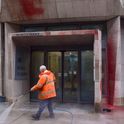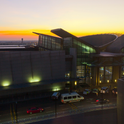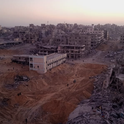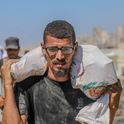Palestinians have called it the Hunger Games. Some Israeli soldiers have described it as something out of a video game. It has only been operating for a month, but the new Israel-backed aid distribution mechanism in Gaza has been the subject of near-daily reports of dozens of Palestinians being shot and killed when trying to access aid.
According to health authorities in the Strip, at least 580 Palestinians have been killed and more than 4,000 wounded while trying to collect aid since 27th May. Many of those deaths occurred at or near facilities administered by the shadowy Gaza Humanitarian Foundation (GHF). At these hubs, American contractors distribute limited quantities of food to starving crowds while Israeli troops and Israeli-armed local militiamen stand guard.
Late last week, Israel’s Haaretz newspaper published an investigation revealing how senior Israeli commanders have instructed soldiers to shoot directly into crowds waiting to receive humanitarian aid, even when they pose no threat to the soldiers’ safety. One soldier interviewed for the article described the aid sites as “a killing field". The army routinely resorts to “live fire with everything imaginable: heavy machine guns, grenade launchers, mortars,” he said, adding, “Our form of communication is gunfire.” Israel’s leaders quickly dismissed the Haaretz investigation as “vicious lies” and “blood libel”.
A week before the Haaretz investigation, +972 Magazine, where I’m an editor, published a harrowing collection of testimonies gathered by two reporters in the Strip from Palestinians in Gaza who witnessed these killings at aid centres in recent weeks.
One survivor described seeing Israeli tanks fire mortars into the middle of a crowd that had gathered to receive food, killing dozens. “One young man was blown in half; others had their limbs ripped off,” he recounted. “These were innocent people, unarmed, just trying to get food.”
Another woman who survived the deadliest single attack on aid seekers—in which at least 70 people were killed on 17th June—said she saw “people losing limbs” and “bodies torn apart” when Israeli tanks fired on a crowd in southern Gaza. “Three of my neighbors… were killed. Their bodies were unrecognisable,” she said. “I watched people die while others bled on donkey carts.”
Amid the severe shortage of food in Gaza, the result of Israel’s siege on the territory, tens of thousands of Palestinians continue to return to these distribution sites every day, despite the extreme danger involved. “No one risks their life like this unless they have no other choice,” one survivor, who managed to take home a bag of flour he’d found next to a dead body, told +972. “We go because we’re starving. We go because there is nothing else.”
Israel initially denied responsibility for the killings, which now number in the hundreds. The government still has little to offer by way of explanation. Aside from denying the Haaretz report, this week the Israeli army released a recording of a phone call with a Palestinian resident of Gaza claiming it is Hamas, not the Israeli army or the local militiamen, that shoots Palestinians at the distribution centres.
And yet, amid the numerous reports of deadly fire at Gaza’s aid hubs, the army has taken the rare step of opening its own internal investigation into the matter, overseen by a body that probes incidents suspected of having violated international law. But, as a report last year by Israeli NGO Yesh Din made clear, the army can’t be relied upon to mark its own homework.
It is worth recalling how this new aid regime was established. As sources in international aid organisations in Gaza told Haaretz last November, the Israeli army “turned a blind eye” to a criminal gang systematically looting aid trucks at gunpoint. Then, after claiming Hamas was stealing the aid, Israel shut down all international humanitarian operations in the Strip, imposing a blockade for two-and-half months, ostensibly to weaken Hamas, that brought the population of Gaza to the brink of famine. (It is also worth noting that “starvation as a method of warfare” is one of the war crimes on the International Criminal Court arrest warrant for Benjamin Netanyahu and his former defence minister, Yoav Gallant).
Israel and the US then brought in the GHF to set up a handful of food distribution facilities and enlisted the looting gang to secure them. Given that these facilities—most of which are located along the enclave’s southern border with Egypt—are the only place Palestinians in Gaza can receive aid, numerous humanitarian organisations have denounced them. In a joint letter on 19th May, groups including ActionAid and Christian Aid said the mechanism is “a blueprint for ethnic cleansing”, which includes “the displacement of hundreds of thousands of Palestinians”. And, one month since the GHF started operations, it is clear that desperate people going to its hubs to access aid are risking their lives.
Doctors Without Borders has warned that the operation constitutes “slaughter masquerading as humanitarian aid” and has called for it to be “immediately dismantled”. So long as Israel is allowed to continue restricting the entry of aid into Gaza and impeding the operations of the humanitarian organisations best placed to coordinate its distribution, the killing of starving Gazans will continue.













